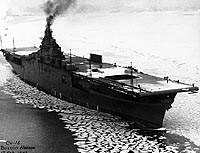
USS Lexington, a 27,100-ton Essex class aircraft carrier, was built at Quincy, Massachusetts. Commissioned in February 1943, she saw her initial combat operations in the September-October raids on Tarawa and Wake. In November and December 1943, Lexington participated in the campaign to seize bases in the Gilbert Islands and batter down Japanese forces in the Marshalls. During attacks on Kawjalein on 4 December, a night air attack hit her in the stern with a torpedo, necessitating two months of shipyard repairs.
Lexington was back in the war zone by early March 1944 and took part in raids in the central Pacific and New Guinea areas during the next few months. In June, she was part of the powerful carrier force that supported the Marianas invasion and won the Battle of the Philippine Sea. For remainder of 1944, Lexington continued her strikes on enemy targets in the central and western Pacific, including attacks on Japanese ships during the October Battle of Leyte Gulf. She was damaged by a suicide plane on 5 November, but was repaired locally. After her planes helped prepare Luzon for invasion in late 1944 and early 1945, Lexington took part in the February 1945 Iwo Jima operation and in carrier attacks on the Japanese Home Islands.
Following a west coast overhaul, Lexington returned to combat for the last two months of the Pacific War, hitting targets in Japan during July and August 1945. Following Japan's surrender, she remained in the western Pacific to support occupation efforts. The carrier returned to the United States in December 1945 and was decommissioned at Bremerton, Washington, in April 1947.
In "mothballs" for the next six years, Lexington began extensive modernization work that was completed in August 1955, when she recommissioned as an attack aircraft carrier (redesignated CVA-16). Now featuring an angled flight deck, steam catapults and many other improvements to accomodate high-performance aircraft, she made five deployments to the western Pacific between 1956 and 1961. In 1962, she was transferred to the Atlantic to relieve USS Antietam as the Navy's training carrier. For this purpose, she was redesignated CVS-16 in October 1962, but briefly remained in the attack carrier role for a few more months during the Cuban Missile Crisis.
For nearly thirty years, Lexington operated in the Gulf of Mexico, providing a seagoing platform for training student Naval Aviators and maintaining the carrier qualifications of more experienced ones. She was redesignated CVT-16 in July 1969 and AVT-16 nine years later. Decommissioned in November 1991, USS Lexington was transferred to a private organization in 1992 and became a museum ship at Corpus Christi, Texas.
This page features selected views of USS Lexington (CV/CVA/CVS/CVT/AVT-16).
| If you want higher resolution reproductions than the digital images presented here, see: "How to Obtain Photographic Reproductions." |
Click on the small photograph to prompt a larger view of the same image.
|
Photo #: 80-G-35657 USS Lexington (CV-16) Steams through floating ice in Boston Harbor, Massachusetts, on 17 February 1943, the day she first went into commission. Note snow on her flight deck, and open catapult track on the starboard side, forward. Official U.S. Navy Photograph, now in the collections of the National Archives. Online Image: 95KB; 740 x 590 pixels Reproductions of this image may also be available through the National Archives photographic reproduction system. |
 |
|
Photo #: 80-G-K-102 (Color) USS Lexington (CV-16) Photographed from USS Cowpens (CVL-25) during raids in the Marshalls and Gilberts Islands, November-December 1943. She is painted in camouflage Measure 21. Official U.S. Navy Photograph, now in the collections of the National Archives. Online Image: 75KB; 740 x 600 pixels Reproductions of this image may also be available through the National Archives photographic reproduction system. |
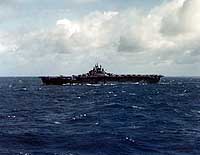 |
|
Photo #: 80-G-366924 USS Lexington (CV-16) Underway during the Gilberts operation, as seen from USS Monterey (CVL-26), November-December 1943. The original photograph is dated 5 December 1943, but must have been taken earlier than that. Official U.S. Navy Photograph, now in the collections of the National Archives. Online Image: 73KB; 740 x 610 pixels Reproductions of this image may also be available through the National Archives photographic reproduction system. |
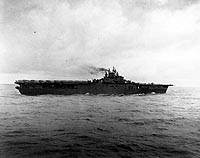 |
|
Photo #: NH 97496 USS Lexington (CVA-16) Arriving in San Francisco Bay, California, circa early 1958, after a four and one-half month overhaul at Puget Sound Naval Shipyard, Bremerton, Washington. The "Lady Lex" has the letters "USO" spelled out on her flight deck by members of her crew, in observance of the United Services Organization fundraising drive then being conducted. Note automobiles parked aft, and a wingless UF "Albatross" behind the island. The original print has the date 8 May 1958 stamped on its reverse. Official U.S. Navy Photograph, from the collections of the Naval Historical Center. Online Image: 164KB; 740 x 610 pixels |
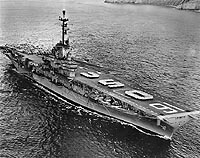 |
|
Photo #: USN 1086588 USS Lexington (CVS-16) Underway on 15 July 1963, with twenty-six T-28 training planes parked forward and amidships. At this time, Naval Academy midshipmen were riding the ship to observe carrier qualifications. Official U.S. Navy Photograph. Online Image: 84KB; 740 x 610 pixels Reproductions of this image may also be available through the National Archives photographic reproduction system as Photo # 428-N-1086588. |
 |
|
Photo #: 80-G-K-16053 (Color) USS Lexington (CV-16) Fighting Squadron Sixteen (VF-16) Commanding Officer, Lieutenant Commander Paul D. Buie, (center) briefs his pilots for an upcoming mission, during the Gilberts operation, November-December 1943. A F6F-3 "Hellcat" fighter is behind them. Photographed by Commander Edward Steichen, USNR. Note flight gear, markings on helmets and life vests. Pilot at left wears a .45 caliber pistol. Official U.S. Navy Photograph, now in the collections of the National Archives. Online Image: 105KB; 740 x 610 pixels Reproductions of this image may also be available through the National Archives photographic reproduction system. |
 |
|
Photo #: 80-G-44605 USS Lexington (CV-16) A F6F-3 "Hellcat" of Fighting Squadron Sixteen (VF-16) gets the take-off flag from Lieutenant John M. Clark, during operations in the Gilberts and Marshalls, 23 November 1943. VF-16 pilots shot down seventeen Japanese aircraft on that day. Official U.S. Navy Photograph, now in the collections of the National Archives. Online Image: 68KB; 740 x 520 pixels Reproductions of this image may also be available through the National Archives photographic reproduction system. |
 |
|
Photo #: 80-G-K-15290 (Color) USS Lexington (CV-16) Aircraft return to the carrier during the Gilberts operation, November 1943. Crewmen in the foreground are sitting on the wing of an SBD-5, as an F6F-3 lands and a TBF-1 taxiies to a parking place on the forward flight deck. Photographed by Commander Edward Steichen, USNR. Official U.S. Navy Photograph, now in the collections of the National Archives. Online Image: 63KB; 740 x 510 pixels Reproductions of this image may also be available through the National Archives photographic reproduction system. |
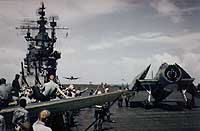 |
|
Photo #: 80-G-236955 Battle of the Philippine Sea, June 1944 An F6F-3 "Hellcat" fighter lands aboard USS Lexington (CV-16) during the "Marianas Turkey Shoot" phase of the battle, 19 June 1944. Note manned 40mm guns in the foreground, and 20mm guns along the starboard side of the flight deck. Official U.S. Navy Photograph, now in the collections of the National Archives. Online Image: 148KB; 740 x 610 pixels Reproductions of this image may also be available through the National Archives photographic reproduction system. |
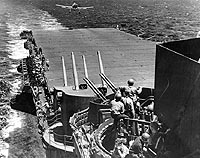 |
|
Photo #: NH 97498 Grumman S-2D "Tracker" anti-submarine aircraft On the port catapult of USS Lexington (CVS-16), 22 January 1963. The Catapult Officer is at left, giving the "launch" signal. Official U.S. Navy Photograph, from the collections of the Naval Historical Center. Online Image: 84KB; 740 x 610 pixels |
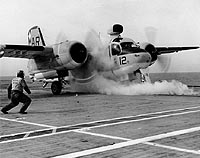 |
|
Photo #: NH 97497 USS Lexington (CVT/AVT-16) Flight deck activity during the 1970s or 1980s. A TA-4J "Skyhawk"is parked in the center, as another passes overhead. Official U.S. Navy Photograph, from the collections of the Naval Historical Center. Online Image: 105KB; 590 x 765 pixels |
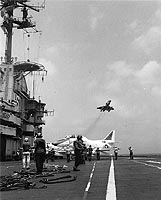 |
| If you want higher resolution reproductions than the digital images presented here, see: "How to Obtain Photographic Reproductions." |
Page made 25 February 2001
Link added 8 October 2001